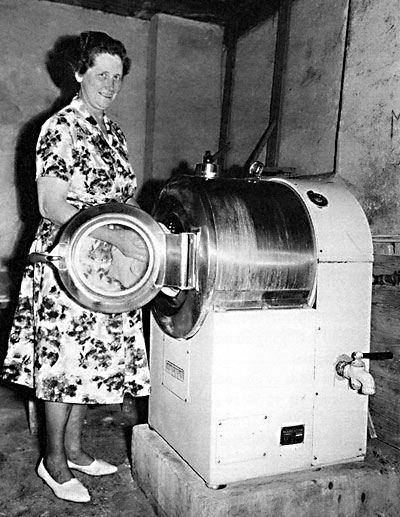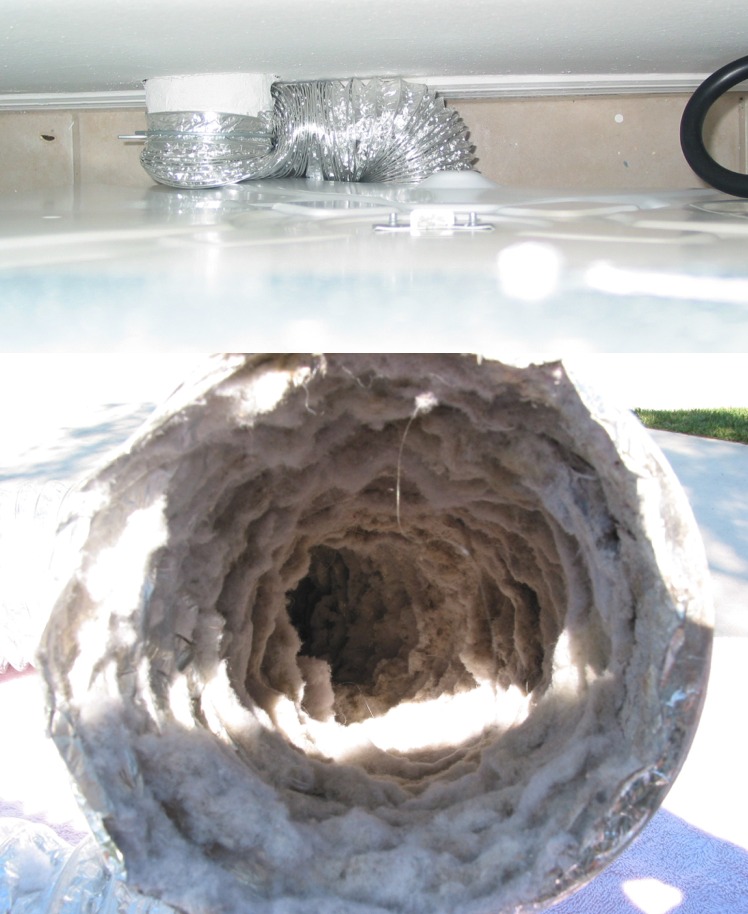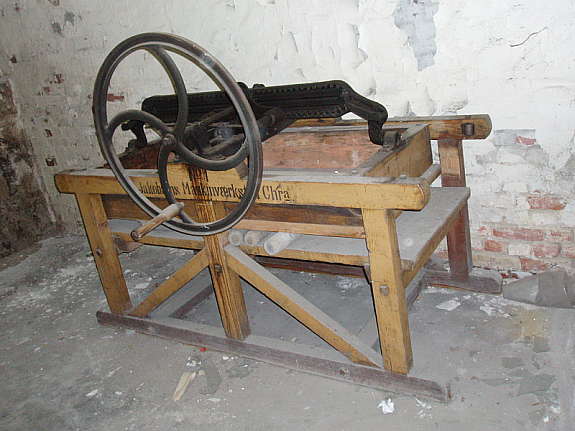|
Wringer
A mangle is a mechanical laundry aid consisting of two rollers in a sturdy frame, connected by cogs and (in its home version) powered by a hand crank or by electricity. Mangles are used to press or flatten sheets, tablecloths, kitchen towels, or clothing and other laundry. The "wringer", a smaller lighter machine of similar appearance and function, was used to squeeze the water out of wet washing. While mangles remain in use in commercial settings, wringers have been made redundant by the spin dry cycle on modern washing machines. History Clothes press The ''Oxford English Dictionary'' dates the first use of the word mangle in English from 1598, quoting John Florio who, in his 1598 dictionary, ''A World of Words'', described "a kind of press to press buckram, fustian, or dyed linen cloth, to make it have a luster or gloss". The word comes from the Dutch , from "to mangle", which in turn derives from the medieval Latin or which ultimately comes from the Greek ''mangan ... [...More Info...] [...Related Items...] OR: [Wikipedia] [Google] [Baidu] |
Ellen Elgin
Ellen F. Eglin (before 1849 – after 1890) was an African-American inventor who invented an improved clothes wringer. Early life and employment Eglin was born in 1849 in Washington, D.C., with few details available about her childhood and earlier life. In her younger years, Eglin was a clerk in a local census office and as a housekeeper where she was a servant to Timothy Nooning and his wife Malintha and their son William. Clothes wringer Eglin's invention was a clothes wringer, no details are recorded. In 1888, Eglin sold the invention to an agent, for $18. According to Charlotte Smith (activist), Charlotte Smith of ''The Woman Inventor,''''The Woman Inventor'' was a single sheet broadsheet published, edited and largely, if not entirely, written by Smith. It ran to two issues. when questioned why she decided to sell her invention, she replied, "You know I am black and if it was known that a Negro woman patented the invention, white ladies would not buy the wringer; I was af ... [...More Info...] [...Related Items...] OR: [Wikipedia] [Google] [Baidu] |
Washing Machine
A washing machine (laundry machine, clothes washer, washer, or simply wash) is a machine designed to laundry, launder clothing. The term is mostly applied to machines that use water. Other ways of doing laundry include dry cleaning (which uses alternative cleaning fluids and is performed by specialist businesses) and ultrasonic cleaning. Modern-day home appliances use electric power to automatically clean clothes. The user adds laundry detergent, which is sold in liquid, powder, or dehydrated sheet form, to the wash water. The machines are also found in commercial laundromats where customers pay-per-use. History Washing by hand Laundering by hand involves soaking, beating, scrubbing, and rinsing dirty textiles. Before indoor plumbing, it was necessary to carry all the water used for washing, boiling, and rinsing the laundry from a pump, Water well, well, or Spring (hydrology), spring. Water for the laundry would be hand-carried, heated on a fire for washing, and then poured i ... [...More Info...] [...Related Items...] OR: [Wikipedia] [Google] [Baidu] |
Laundry Equipment
Laundry is the washing of clothing and other textiles, and, more broadly, their drying and ironing as well. Laundry has been part of history since humans began to wear clothes, so the methods by which different cultures have dealt with this universal human need are of interest to several branches of scholarship. Laundry work has traditionally been highly gendered, with the responsibility in most cultures falling to women (formerly known as laundresses or washerwomen). The Industrial Revolution gradually led to mechanized solutions to laundry work, notably the washing machine and later the tumble dryer. Laundry, like cooking and child care, is still done both at home and by commercial establishments outside the home. The word "laundry" may refer to the clothing itself, or to the place where the cleaning happens. An individual home may have a laundry room; a utility room includes, but is not restricted to, the function of washing clothes. An apartment building or student hall o ... [...More Info...] [...Related Items...] OR: [Wikipedia] [Google] [Baidu] |
Rubber
Rubber, also called India rubber, latex, Amazonian rubber, ''caucho'', or ''caoutchouc'', as initially produced, consists of polymers of the organic compound isoprene, with minor impurities of other organic compounds. Types of polyisoprene that are used as natural rubbers are classified as elastomers. Currently, rubber is harvested mainly in the form of the latex from the Hevea brasiliensis, Pará rubber tree (''Hevea brasiliensis'') or others. The latex is a sticky, milky and white colloid drawn off by making incisions in the bark and collecting the fluid in vessels in a process called "tapping". Manufacturers refine this latex into the rubber that is ready for commercial processing. Natural rubber is used extensively in many applications and products, either alone or in combination with other materials. In most of its useful forms, it has a large stretch ratio and high resilience and also is buoyant and water-proof. Industrial demand for rubber-like materials began to out ... [...More Info...] [...Related Items...] OR: [Wikipedia] [Google] [Baidu] |
List Of Home Appliances
A home appliance, also referred to as a domestic appliance, an electric appliance or a household appliance, is a machine which assists in household functions such as cooking, cleaning and food preservation. The domestic application attached to home appliance is tied to the definition of appliance as "an instrument or device designed for a particular use or function". ''Collins English Dictionary'' defines "home appliance" as: "devices or machines, usually electrical, that are in your home and which you use to do jobs such as cleaning or cooking". The broad usage allows for nearly any device intended for domestic use to be a home appliance, including consumer electronics as well as stoves, refrigerators, toasters and air conditioners. The development of self-contained electric and gas-powered appliances, an American innovation, emerged in the early 20th century. This evolution is linked to the decline of full-time domestic servants and desire to reduce household chores, allowing ... [...More Info...] [...Related Items...] OR: [Wikipedia] [Google] [Baidu] |
Cold Pad Batch
Cold pad batch (CPB) is a method of dyeing textiles, typically cellulosic fibers such as cotton, in which the textile is impregnated with dye in a cold state, rather than being heated. High dye fixation and no thermal energy are the advantages of the CPB process. CPB-dyed fabrics are less expensive, have a softer hand feel, and have a cleaner surface than exhaust dyed materials. The process may take up to 12 hours in the batching process, depending on the depth of the shade. The disadvantage is that batching is a time-consuming and lengthy process. The process was developed in 1960. During the dyeing process, the dye must become close and even with the material in order to produce a uniform color that is fast to moisture, heat, and light. Due to their superior fastness properties and simple application, reactive dyes are currently the most common type of dye for cotton dyeing. The CPB technique uses less water and energy. This approach eliminates the typical salt used to exhaust re ... [...More Info...] [...Related Items...] OR: [Wikipedia] [Google] [Baidu] |
Clothes Horse
A clothes horse is a portable frame, usually made of wood, metal, or plastic, upon which wet laundry is hung to dry by evaporation. Usage and alternatives Clothes horses are a cheap, low-tech type of laundry equipment, in contrast to a clothes dryer, which requires electricity or natural gas to operate, or a clothes line or Hills Hoist, which requires ample outdoor space, wind, and fine weather. In the past, they also served as an alternative to airing cupboards. In cold, damp seasons and in the absence of central heating, a clothes horse placed by a fireside or a kitchen range provides a place to warm clothing before putting it on. The practice of airing, once common in Great Britain (for example, in the constant battle against damp and mold), has become far less frequent with the advent of central heating and affordable clothes dryers. Terminology Other names for this device include a clothes rack, drying horse, clothes maiden, drying rack, scissor rack, drying stand, or aire ... [...More Info...] [...Related Items...] OR: [Wikipedia] [Google] [Baidu] |
Etching
Etching is traditionally the process of using strong acid or mordant to cut into the unprotected parts of a metal surface to create a design in intaglio (incised) in the metal. In modern manufacturing, other chemicals may be used on other types of material. As a method of printmaking, it is, along with engraving, the most important technique for old master prints, and remains in wide use today. In a number of modern variants such as microfabrication etching and photochemical milling, it is a crucial technique in modern technology, including circuit boards. In traditional pure etching, a metal plate (usually of copper, zinc or steel) is covered with a waxy ground which is resistant to acid. The artist then scratches off the ground with a pointed etching needle where the artist wants a line to appear in the finished piece, exposing the bare metal. The échoppe, a tool with a slanted oval section, is also used for "swelling" lines. The plate is then dipped in a bath of aci ... [...More Info...] [...Related Items...] OR: [Wikipedia] [Google] [Baidu] |
Barbara Brash
Barbara Nancy Brash (3 November 1925 – 25 February 1998) was a twentieth-century post-war Australian artist known for her painting and innovative printmaking. In an extensive career she contributed to the Melbourne Modernist art scene, beside other significant women artists including: Mary Macqueen, Dorothy Braund, Anne Marie Graham, Constance Stokes, Anne Montgomery (artist) and Nancy Grant.Art Nomad "Dorothy Mary Braund" Art Nomad, accessed 6 July 2022 Biography Barbara Nancy Brash was born in Melbourne on 3 November 1925 to Elsa and Alfred Brasch. The Brasch family had established Brasch Brothers and Salenger partnership in 1866 and opened Braschs music store at 108 Elizabeth Street. Reacting to prejudice against German n ...[...More Info...] [...Related Items...] OR: [Wikipedia] [Google] [Baidu] |
Clothes Dryer
A clothes dryer (tumble dryer, drying machine, drying device, or simply dryer) is a powered Home appliance, household appliance that is used to remove moisture from a load of clothing, bedding and other textiles, usually after they are washed in the washing machine. Many dryers consist of a rotating drum called a "tumbler" through which heated air is circulated to evaporate moisture while the tumbler is rotated to maintain air space between the articles. Using such a machine may cause clothes to Shrinkage (fabric), shrink or become less soft (due to loss of short soft fibers). A simpler non-rotating machine called a "drying cabinet" may be used for delicate fabrics and other items not suitable for a tumble dryer. Other machines include steam to de-shrink clothes and avoid ironing. Tumble dryers Tumble dryers continuously draw in the Ambient air quality criteria, ambient air around them and heat it before passing it through the tumbler. The resulting hot, humid air is usually vent ... [...More Info...] [...Related Items...] OR: [Wikipedia] [Google] [Baidu] |
Modern Mangle In A Swedish Laundry Room
Modern may refer to: History *Modern history ** Early Modern period ** Late Modern period *** 18th century *** 19th century *** 20th century ** Contemporary history * Moderns, a faction of Freemasonry that existed in the 18th century Philosophy and sociology * Modernity, a loosely defined concept delineating a number of societal, economic and ideological features that contrast with "pre-modern" times or societies ** Late modernity Art * Modernism ** Modernist poetry * Modern art, a form of art * Modern dance, a dance form developed in the early 20th century * Modern architecture, a broad movement and period in architectural history ** Moderne, multiple architectural styles ** Modernisme a.k.a. Catalan Modernism * Modern music (other) Geography * Modra, a Slovak city, referred to in the German language as "Modern" Typography * Modern (typeface), a raster font packaged with Windows XP * Another name for the typeface classification known as Didone (typography) * Mode ... [...More Info...] [...Related Items...] OR: [Wikipedia] [Google] [Baidu] |
Box Mangle
The box mangle is said to have been invented in the 17th century. It consisted of a heavy frame containing a large box filled with rocks, resting on a series of long wooden rollers. Damp laundry could be laid flat under rollers, or wound round the rollers: sometimes enclosed in a sheet in order to keep the laundry clean. When the rollers were filled, one or two people pulled on levers or turned cranks to move the heavy box back and forth over the rollers. The mangle's primary purpose was to press household linen and clothing smooth. This was a mechanical version of the hand-held mangle boards and rollers/pins used in many parts of northern Europe. Nowadays the word mangle suggests a wringing device for removing water from laundry in some English-speaking countries, but the box mangle was used for pressing and smoothing, and was an alternative to hot ironing Ironing is the use of an iron (appliance), iron, usually heated, to remove wrinkles and unwanted creases from fabric. T ... [...More Info...] [...Related Items...] OR: [Wikipedia] [Google] [Baidu] |





